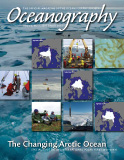Full Text
Perhaps more than any other ocean region, the Arctic has grabbed public attention as the embodiment of the impacts of climate change. We have seen pictures of stranded walrus pups and displaced polar bears. We have read about new trade routes and petroleum exploration in previously ice-covered seas. Earlier ice retreat and the absence of ice have changed the wind-driven mixing, ecology, and biogeochemistry of Arctic seas.
While many of these changes are tragic for both the affected species and the humans who depend on them, they also present an opportunity and obligation to examine the interdependent climate-oceanography-human dimension of the Arctic. Interdisciplinary approaches for Arctic research, such as those described in articles in this issue of Oceanography, can be used effectively to gain new insights and to provide important “teaching moments” that demonstrate the complex effects of climate change to the public and to policymakers.
As funding agencies set priorities for funding in the years ahead, we need to make sure that the effects of climate change in the Arctic are a top priority.
– Mike Roman, TOS President

